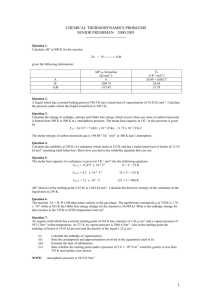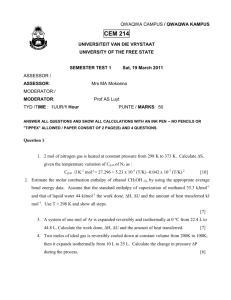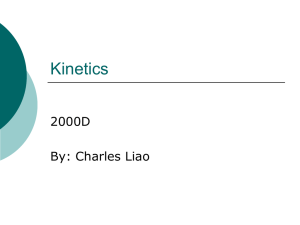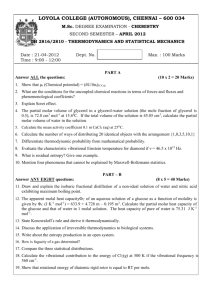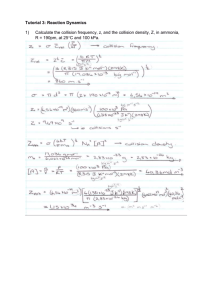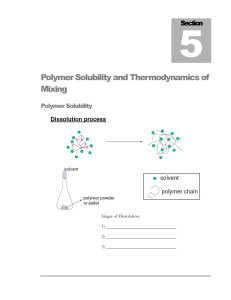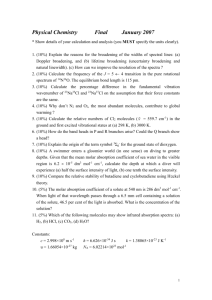∫ ∫
advertisement
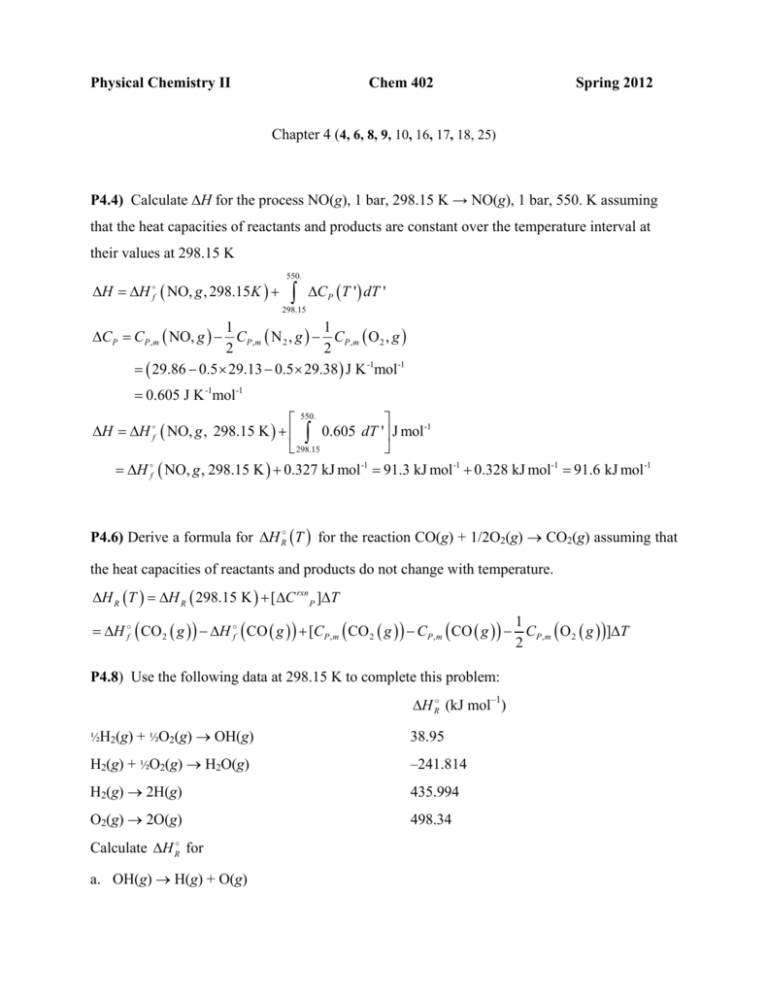
Physical Chemistry II Chem 402 Spring 2012 Chapter 4 (4, 6, 8, 9, 10, 16, 17, 18, 25) P4.4) Calculate H for the process NO(g), 1 bar, 298.15 K → NO(g), 1 bar, 550. K assuming that the heat capacities of reactants and products are constant over the temperature interval at their values at 298.15 K 550. H H f NO, g , 298.15K CP T ' dT ' 298.15 1 1 CP CP ,m NO, g CP ,m N 2 , g CP ,m O 2 , g 2 2 29.86 0.5 29.13 0.5 29.38 J K -1mol-1 0.605 J K -1mol-1 550. H H f NO, g , 298.15 K 0.605 dT ' J mol-1 298.15 -1 H f NO, g , 298.15 K 0.327 kJ mol 91.3 kJ mol-1 0.328 kJ mol-1 91.6 kJ mol-1 P4.6) Derive a formula for H R T for the reaction CO(g) + 1/2O2(g) CO2(g) assuming that the heat capacities of reactants and products do not change with temperature. H R T H R 298.15 K [C rxn P ]T 1 H f CO 2 g H f CO g [CP , m CO 2 g CP ,m CO g CP ,m O 2 g ]T 2 P4.8) Use the following data at 298.15 K to complete this problem: H R (kJ mol–1) ½H2(g) + ½O2(g) OH(g) 38.95 H2(g) + ½O2(g) H2O(g) –241.814 H2(g) 2H(g) 435.994 O2(g) 2O(g) 498.34 Calculate H R for a. OH(g) H(g) + O(g) b. H2O(g) 2H(g) + O(g) c. H2O(g) H(g) + OH(g) Assuming ideal gas behavior, calculate H R and U R for all three reactions. H reaction kJ mol-1 a) OH(g) → ½H2(g) + ½O2(g) –38.95 ½H2(g) → H(g) ½ 435.994 ½O2(g) → O (g) ½ 498.34 ____________________________________________________________ OH(g) H(g) + O(g) = 428.22 kJ mol-1 H reaction = H reaction U reaction nRT = 428.22 kJ mol-1 – 8.314 J mol-1 K-1 298.15 K = 425.74 kJ mol-1 H reaction kJ mol-1 b) H2O(g) H2(g) + ½O2(g) H2(g) 2H(g) ½ O2(g) → O (g) 241.814 435.994 ½ 498.34 _______________________________________________________ H2O(g) 2H(g) + O(g) = 926.98 kJ mol-1 H reaction = H reaction U reaction nRT = 926.98 kJ mol-1 – 2 8.314 J mol-1 K-1 298.15 K = 922.02 kJ mol-1 H reaction kJ mol-1 c) H2O(g) H2(g) + ½O2(g) 241.814 ½H2(g) + ½O2(g) OH(g) 38.95 ½H2(g) H(g) ½ 435.994 _________________________________________________________ H2O(g) H(g) + OH(g) = 498.76 kJ mol-1 H reaction = H reaction U reaction nRT = 498.76 kJ mol-1 – 8.314 J mol-1 K-1 298.15 K = 496.28 kJ mol-1 P4.9) Calculate the standard enthalpy of formation of FeS2(s) at 300.°C from the following data at 298.15 K. Assume that the heat capacities are independent of temperature. Substance Fe(s) FeS2(s) S(rhombic) –824.2 H f (kJ mol–1) 3.02 CP , m /R Fe2O3(s) 7.48 SO2(g) –296.81 2.72 You are also given: = –1655 kJ mol-1 2FeS2(s) + 11/2O2(g) Fe2O3(s) + 4SO2(g) ; H reaction 1655 kJ mol 1 H f Fe 2 O3 ,s 4H f SO 2 , g 2 H f Fe 2S2 , s H f Fe2S2 , s,298 K 1655 kJ mol-1 H f Fe 2 O3 , s 4H f SO 2 , g 2 1655 824.2 4 296.81 kJ mol -1 = 2 -1 178.2 kJ mol The enthalpy of formation at 300. C is given by 573 K H f FeS s ,573 K H FeS s , 298 K 2 f 2 C p T ' dT ' 298 K Because the heat capacities are assumed to be independent of T, H f FeS2 s ,573 K H f FeS2 s , 298 K CP ,m FeS2 , s CP ,m Fe, s 2CP ,m S, s 573 K 298 K 178.2 kJ mol-1 8.314 J K -1 mol-1 7.48 3.02 2 2.70 573 K 298 K 180.0 kJ mol-1 P4.10) The data below are a DSC scan of a solution of a T4 lysozyme mutant. From the data determine Tm. Determine also the excess heat capacity CP at T = 308 K. Determine also the intrinsic C Pint and transition C Ptrs excess heat capacities at T = 308 K. In your calculations use the extrapolated curves, shown as dotted lines in the DSC scan, where the y axis shows CP. Cptrs = 0.83 J K-1 g-1 Cp = 1.25 J K-1 g-1 Cpint = 0.42 J K-1 g-1 Tm = 304 K P4.16) The total surface area of the earth consisting of forest, cultivated land, grass land, and desert is 1.49x108 km2. Every year, the mass of carbon fixed by photosynthesis by vegetation covering this land surface according to the reaction 6CO2 g 6H 2O l C6 H12O6 s 6O2 g is about 450. metric Tons km-2. Calculate the annual enthalpy change resulting from photosynthetic carbon fixation over the land surface per mole of carbon given the data above. Assume P = 1 bar and T = 298 K. HR = H f (C6H12O6 (s)) ─6 H f (H2O(l)) ─ 6 H f (CO2(g)) 1273.1 kJ mol 1 6 393.5 kJ mol1 6 285.5 kJ mol1 2802.7 kJ mol1 The number of moles of fixed carbon is: nC , fixed mC , fixed MC 4.50 10 kg km year 3.747 10 12.0110 kg mol 5 -2 -3 -1 7 -1 mol km -2 year -1 We calculate the enthalpy change per mole of C using the above result: 7 -2 -1 -1 8 2 H R 3.747 10 mol km year 2802 kJ mol 1.49 10 km H 6 6 18 -1 2.60 10 kJ year P4.17) Calculate H R and U R at 298.15 K for the following reactions: a. 4NH3(g) + 6NO(g) → 5N2(g) + 6H2O(g) b. 2NO(g) + O2(g) → 2NO2(g) c. TiCl4(l) + 2H2O(l) → TiO2(s) + 4HCl(g) d. 2NaOH(aq) + H2SO4(aq) → Na2SO4(aq) + 2H2O(l) Assume complete dissociation of NaOH, H2SO4, and Na2SO4 e. CH4(g) + H2O(g) → CO(g) + 3H2(g) f. CH3OH(g) + CO(g) → CH3COOH(l) a) 4NH3(g) + 6NO(g) → 5N2(g) + 6H2O(g) H reaction 5H f N 2 , g 6H f H 2 O, g 4H f NH 3 , g 6H f NO, g 0 6 241.8 kJ mol-1 4 45.9 kJ mol-1 6 91.3 kJ mol-1 1815.0 kJ mol-1 U reaction H reaction nRT 1815.0 kJ mol-1 8.314 J K -1mol-1 298.15 K 1817.5 kJ mol-1 b) 2NO(g) + O2(g) → 2NO2(g) H reaction 2H f NO 2 , g H f O 2 , g 2H f NO, g 2 33.2 kJ mol-1 0 2 91.3 kJ mol-1 116.2 kJ mol-1 U reaction H reaction nRT 116.2 kJ mol-1 8.314 J K -1mol-1 298.15 K 113.7 kJ mol-1 c) TiCl4(l) + 2H2O(l) → TiO2(s) + 4HCl(g) H reaction H f TiO 2 , s 4H f HCl, g H f TiCl4 , l 2H f H 2 O, l 944 4 92.3 kJ mol-1 804.2 kJ mol-1 2 285.8 kJ mol-1 62.6 kJ mol-1 U reaction H reaction nRT 62.6 kJ mol-1 4×8.314 J K -1mol-1 298.15 K 52.7 kJ mol-1 d) 2NaOH(aq) + H2SO4(aq) → Na2SO4(aq) +2H2O(l) Assume that NaOH(aq) and H2SO4(aq) are completely dissociated. The overall reaction is 2OH - aq + 2H + aq 2H 2 O(l ) H reaction 2H f H 2 O, l 2H f H + , aq 2H f OH - , aq 2 285.8 kJ mol-1 0 2 230.0 kJ mol-1 111.6 kJ mol-1 U reaction H reaction nRT 111.6 kJ mol-1 0 111.6 kJ mol-1 e) CH4(g) + H2O(g) → CO(g) + 3H2(g) H reaction H f CO, g 3H f H 2 , g H f CH 4 , g H f H 2 O, g 110.5 kJ mol-1 0 74.6 kJ mol-1 241.8 kJ mol-1 205.9 kJ mol-1 U reaction H reaction nRT 205.9 kJ mol-1 2 8.3145 J K -1mol-1 298.15 K 200.9 kJ mol-1 f) CH3OH(g) + CO(g) → CH3COOH(l) H reaction H f CH 3 COOH, l H f CH 3 OH, g H f CO, g 484.3 kJ mol-1 201.0 kJ mol-1 110.5 kJ mol-1 172.8 kJ mol-1 U reaction H reaction nRT 172.8 kJ mol-1 2 8.3145 J K -1mol-1 298.15 K 167.8 kJ mol-1 P4.18) A sample of Na2SO4(s) is dissolved in 225 g of water at 298 K such that the solution is 0.250 molar in Na2SO4. A temperature rise of 0.112°C is observed. The calorimeter constant is 330. J K–1. Calculate the enthalpy of solution of Na2SO4 in water at this concentration. Assume that the solution volume is the same as the solvent volume. Compare your result with that calculated using the data in Table 4.1 (Appendix B, Data Tables). 0 mH 2O ms H solution ,m CH O ,m T Ccalorimeter T Ms M H 2O 2 H solution ,m 225 g 75.3 J K -1mol-1 0.112o C 330 J K -1 0.112o K -1 18.02 g mol 0.225 kg 0.250 mol L1 0.997 kg L1 2.52 103 J mol-1 H solution ,m 2H solution ,m Na , aq H solution ,m SO 24 , aq H f Na 2SO 4 , s 2 240.1103 J mol-1 909.3103 J mol-1 1387.1103 J mol-1 2.4 103 J mol-1 2.52 kJ mol-1 2.4 kJ mol-1 The relative error is 4.8% 2.52 kJ mol-1 P4.25) Using the protein DSC data in Problem 4.10, calculate the enthalpy change between the T = 288 K and T = 318 K. Give your answer in units of kJ per mole. Assume the molar mass of the protein is 14000. grams per mole. Hint: You can perform the integration of the heat capacity by estimating the area under the DSC curve and above the dotted baseline in problem 4.28. This can be done by dividing the area up into small rectangles and summing the areas of the rectangles. Comment on the accuracy of this method. There are approximately 624 squares in the yellow area. On the horizontal axis, 1 square = 0.50 K. On the vertical axis, 1 square = 0.0418 J K-1 g-1. we obtain: H m 624 0.50 K 0.0418 J K 1 g 1 14000. g mol 1 1.8 10 2 kJ mol 1 The method is reasonably accurate because the number of squares can be counted quite accurately.

